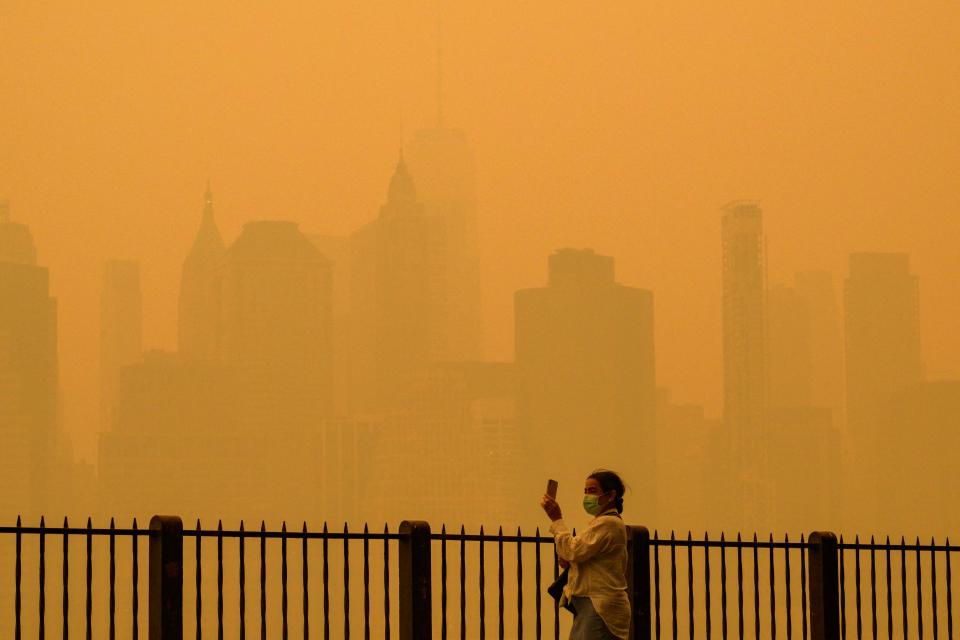Canadian wildfires have started. Will smoke descend on the USA like last year?
Remember the watery eyes, inflamed lungs and the apocalyptic orange skies of last summer?
The smoke that descended over swaths of the U.S. was primarily caused by distant wildfires in Canada – and those fires are back. So will the U.S. have a repeat of the smoky, unhealthy skies?
Top Canadian fire experts offered mixed answers for 2024: "It is extremely unlikely that the 2024 fire season will be as extreme as 2023, as 2023 was a record-smashing year," Mike Flannigan, a professor of wildland fire at Thompson Rivers University in British Columbia, told USA TODAY.
However, he said there is an existing drought across Canada and forecasts call for a warmer-than-normal summer, so "these factors suggest the potential for an active fire season."
Another expert, Rebecca Saari, an associate professor in the department of civil and environmental engineering at the University of Waterloo in Ontario, also pointing to the drought and warm forecast, told USA TODAY that she sees "similar patterns to last year."

How bad were the fires in Canada in 2023?
In 2023, Canada endured its worst year for wildfires, with more than 6,600 blazes burning 37 million acres, an area roughly seven times the annual average. Eight firefighters died and 230,000 people were evacuated from their homes across Canada.
“The word ‘unprecedented’ doesn’t do justice to the severity of the wildfires in Canada (in 2023),” said Yan Boulanger, research scientist in forest ecology at Natural Resources Canada, in a statement.
Report: U.S. air pollution worst in 25 years as new environmental regulations finalized
In the U.S., thick smoke from the fires – pushed around by what Saari called an "unlucky weather pattern" – wafted its way across the border, settling over such major metropolitan areas as New York City and Chicago, bringing hazardous to dangerous air quality to tens of millions of people.
Was climate change a factor?
Climate change more than doubled the likelihood of extreme fire weather in eastern Canada last year, according to a report prepared last year by the World Weather Attribution group.
What's going on in Canada now?
Wildfires were reported across the western Canadian province of Alberta this week, forcing dozens of people from their homes. The evacuation orders mark what is expected to be another severe year for wildfires in western Canada, authorities said, which is dealing with widespread drought and warmer-than-normal spring temperatures.
Whether or not smoke from fires in Canada makes its way to the U.S. this year will depend on weather patterns at the time the fires are at their worst.
What's the wildfire forecast in the U.S.?
AccuWeather, in its 2024 wildfire forecast released this week, said that the upcoming wildfire season in the U.S. is not expected to shatter records, but "millions of people may still face hazardous air quality from blazes burning across the country and Canada."
Overall, AccuWeather said that the 2024 U.S. wildfire season is expected to be below average in terms of the number of fires and acres burned. Fires across the country are predicted to burn between 4 and 6 million acres of land in 2024, below the historical average of around 7 million acres.
It's already been a newsworthy year for wildfires in the U.S.: Due mainly to the wildfires that roared across the grasslands of Texas in March, some 1.7 million acres have burned in the U.S. so far this year, according to the National Interagency Fire Center in Boise, Idaho. That's the most since 2017 and more than double the average of around 700,000 acres (to date), the center said.
What can you do to stay fire-aware?
During the past decade, wildfires have become more destructive, the fire center said in a statement. "These sometimes-historic blazes can be attributed to several factors. Accumulated fuel, like dead trees and brush, becomes a tinderbox ready to burn when combined with drought."
"We cannot stop hot weather and lightning storms, but we can do our part to be fire-wise when we are recreating, traveling, or maintaining our homes," the fire center advised.
Take the time to find out the weather conditions and fire danger where you live and plan to vacation, the fire center said. Get the information you need here about current wildland fire danger and be prepared.
Contributing: Reuters
This article originally appeared on USA TODAY: Canadian wildfires have begun. Will smoke cover the USA again?
